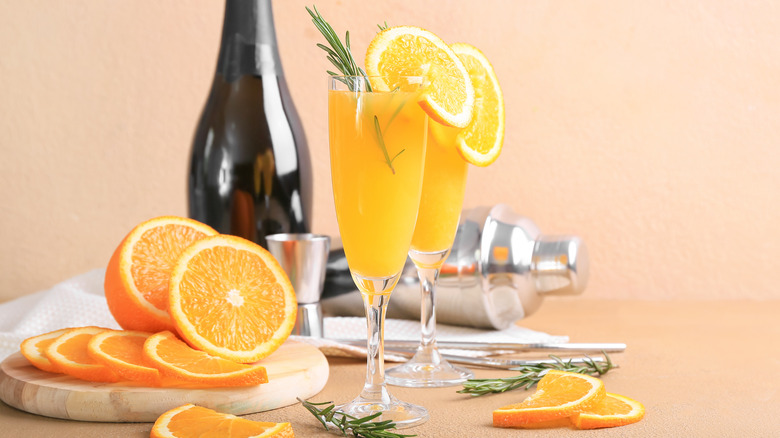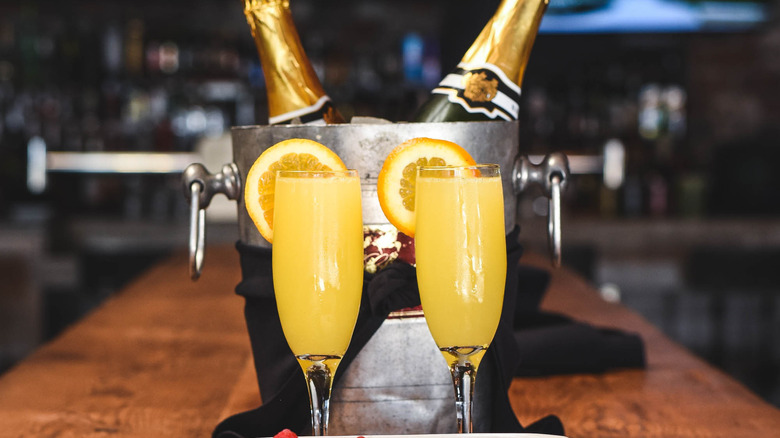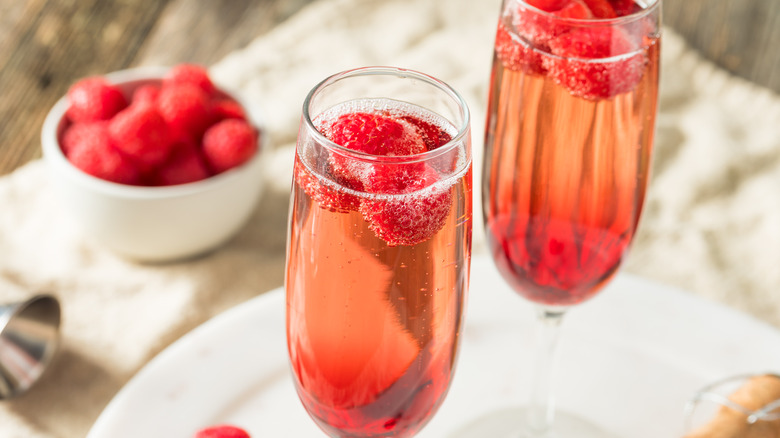The 2-Ingredient Cocktail You Should Have Memorized By Now
Before diving into the subject of two-ingredient cocktails, let's acknowledge the pink elephant in the room: There are certain mixologists who would say there's no such thing, as they feel that just two ingredients make a mixed drink and only three or more make a cocktail (not a crowd). I'm not quite so pedantic, however (though it's been quite a while since my brief stint as a bartender), so I'm going with the definition of cocktail as any kind of booze plus mixer(s), and it seems that Difford's Guide agrees. It definitively classifies the mimosa — which is my pick as the two-ingredient drink that everyone should have in their repertoire — as a cocktail.
The mimosa is often thought of as a brunch drink, as it makes for relatively guilt-free day drinking due to the fact that it is both low in alcohol and high in vitamin C. Those properties, however, make it well suited to afternoons by the pool (even if it's a plastic kiddie pool), and it's not bad in the evenings, either. It also makes for economical entertaining since cheap sparkling wine will be disguised by the flavor of the orange juice.
How to mix a marvelous mimosa
If you've memorized the mimosa, you may think you know all about making them. All you do is combine orange and sparkling wine, right? Well, yes, but there are still a few tips and tricks that will help you improve the drink. For one thing, you should pour the bubbly stuff into the glass first and then add the juice. If you do it the other way around, the champagne may spill over the top and make a mess. In order to keep the drink as fizzy as possible, you should also refrain from stirring (or shaking). Instead, simply let the two liquids combine into one.
If you're not an OJ fan, you can enjoy mimosas made with different types of juice. Bartending lore even assigns special names to a few such combinations, with the poinsettia being made with cranberry juice, the megmosa with grapefruit juice, the lemosa with lemonade, the vermosa with apple juice, and the soleil with pineapple juice. You may also feel free to use pomegranate, blueberry, watermelon, or even prune juice if you wish, although you're on your own when it comes to naming these. (Perhaps this last one could be called the movemosa in tribute to its laxative properties.)
Why I didn't pick these mimosa-adjacent drinks
The screwdriver is kind of like the mimosa's hard-drinking cousin, but it doesn't get my nod because it's less versatile and sophisticated, although it does have the benefit of helping you ward off scurvy as you booze it up and is super easy to throw together, if you consider both orange juice and vodka to be household staples. The same goes for the screwdriver variant called the fuzzy navel, which replaces the vodka with less-boozy peach schnapps – while it may be better-suited for day drinking, it tends to be overly sugary, and super-sweet drinks make exceptionally nasty hangovers.
The Bellini, another popular brunch drink with a sparkling wine base, is a bit more fussy to make, since, for one thing, you're supposed to use prosecco instead of any sparkling wine you have on hand, and, for another, you need to putz around making peach puree. The kir royale, a drink whose name sounds as posh as its ingredients, is more spirit-forward than the mimosa, as it combines champagne and the blackcurrant liqueur called crème de cassis. Since it tends to contain a higher proportion of sparkling wine to mixer than the mimosa, you really can't get away with the cheap stuff, thus making it more suited to elegant occasions than everyday imbibing.


